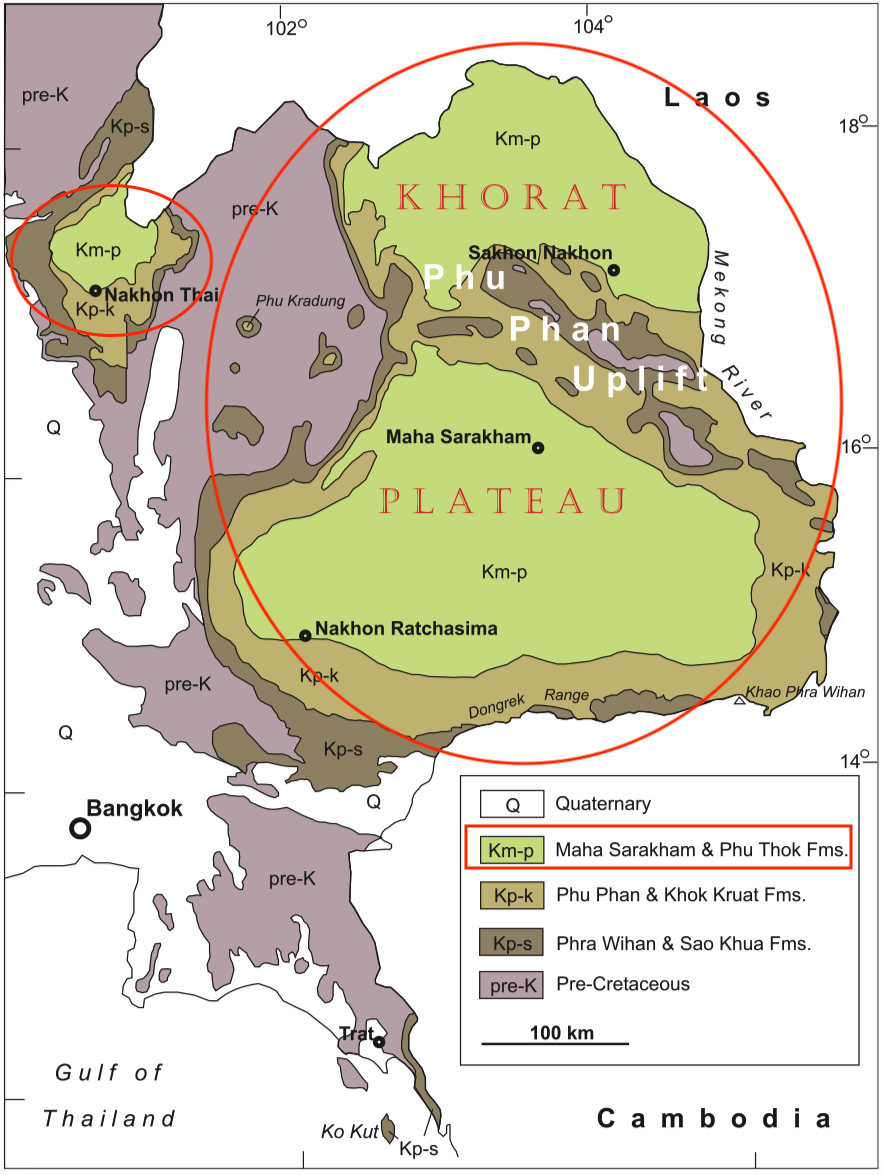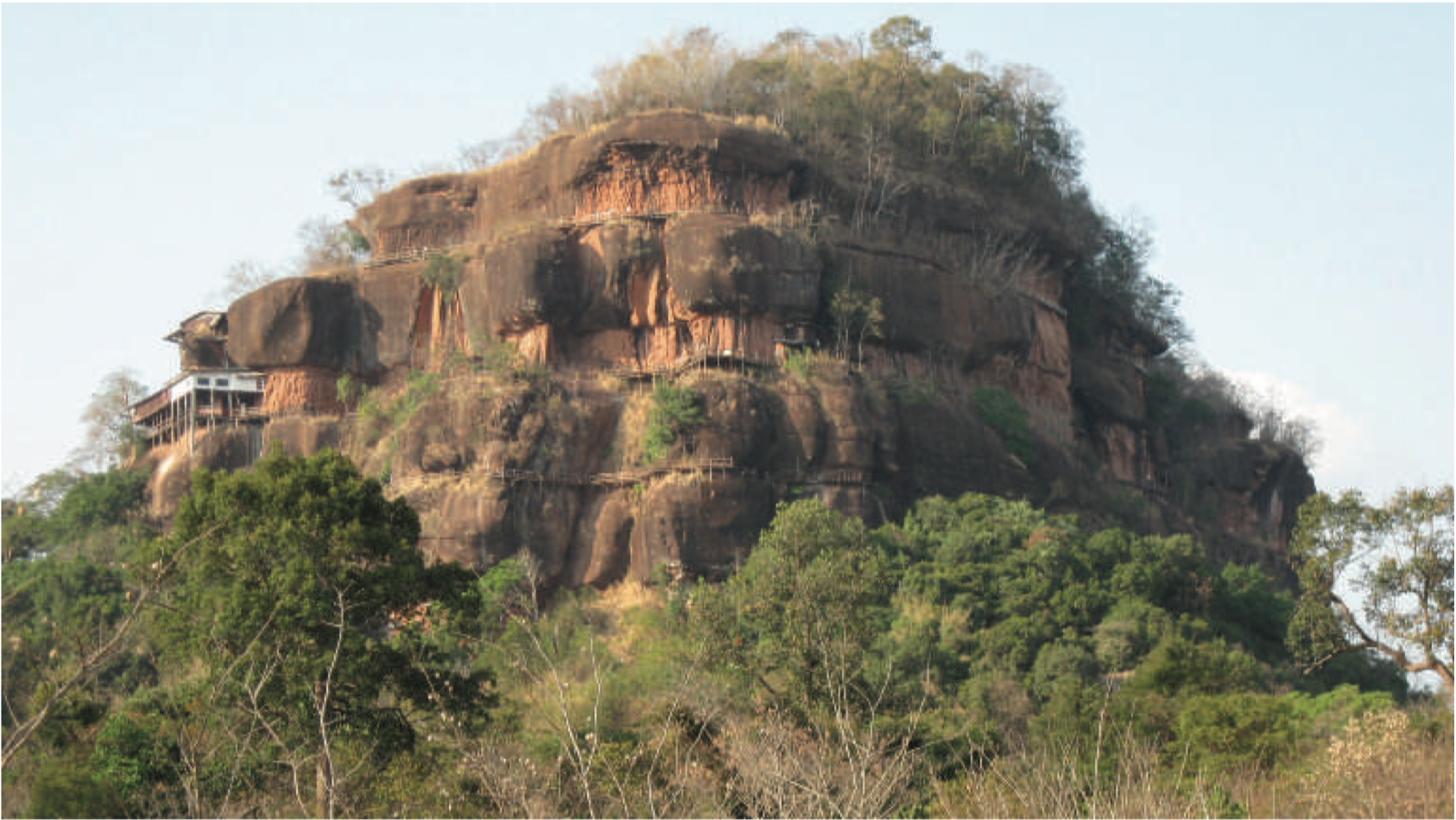Phu Thok Fm
Period:
Cretaceous
Age Interval:
late Cretaceous and maybe Lower Paleogene (13, 14, 15)
Province:
Indochina Block: Khorat Plateau, Indochina Block: Loei Fold Belt
Type Locality and Naming
Phu Tok, Bung Kan district, Bung Kan province of The Khorat Plateau by Sattayarak (1985). Parent unit: Khorat Gr.
Synonym: หมวดหินภูทอก; Phu Tok Formation (หมวดหินภูทอก)
[Figure: NE and SE Thailand, showing distribution of Cretaceous outcrops. (Meesook, 2011. Page 170). At least some of the Pre-Cretaceous sedimentary rocks on the map may be Jurassic and the position of the Jurassic-Cretaceous boundary is discussed in Meesook (2011).]
Lithology and Thickness
Sandstone, brick-red, fine- to medium-grained, thick-bedded to massive, very large-scale cross-bedding and small scale wavy bed. The formation can be divided into three informal members: (in ascending order) the Nawa, Kham Takla and Phuthok Noi members with a total thickness of 200–350 m. The sequence coarsens upwards. The Nawa member comprises reddish-brown siltstone and claystone beds with disseminated gypsum at the base and calcite vugs in the upper part. The Kham Takla member is characterized by fine-grained sandstone interbedded with siltstone and claystone; desiccation cracks are common. The Phuthok Noi member consists of brick-red fine- to medium-grained thick-bedded sandstone with large-scale cross-bedding (Meesook, 2011). Thickness: 100m by Lexicon of Stratigraphic Names of Thailand (2013); 200–350 m by Meesook (2011).
[Figure: Sandstone of the Phuthok Noi member, Phu Thok Formation, Phu Thok Noi, Nong Khai Province (Meesook, 2011).]
Lithology Pattern:
Sandstone
Relationships and Distribution
Lower contact
Maha Sarakham Fm (conformable)
Upper contact
unnamed Quaternary (unconformable)
Regional extent
The Khorat Plateau. The Phu Thok Formation is well exposed in the northern and central parts of the Khorat Plateau and in the low-lying areas of the central, southern and south-western Phu Phan Range.
GeoJSON
{"type":"Feature","geometry":{"type":"Polygon","coordinates":[[[100.86,17.97],[100.84,17.82],[100.73,17.64],[100.5,17.26],[100.28,16.84],[100.18,16.41],[100.28,15.88],[100.48,15.55],[100.45,15.3],[100.53,14.96],[100.66,14.73],[100.91,14.5],[101.11,14.45],[101.51,14.44],[102.13,14.69],[102.42,14.84],[102.67,14.92],[102.84,14.96],[103.08,14.98],[103.24,15.04],[103.43,15.12],[103.51,15.18],[103.65,15.34],[103.72,15.57],[103.73,16.03],[103.66,16.46],[103.45,16.87],[103.16,17.27],[102.66,17.53],[102.29,17.74],[101.89,17.99],[101.7,17.96],[101.63,17.81],[101.48,17.81],[101.34,17.66],[101.16,17.49],[100.98,17.53],[100.93,17.66],[100.99,17.81],[101.1,17.99],[100.86,17.97]]]}}
Fossils
Due to the increase in aridity to the overlying Phu Thok Fm from the Maha Sarakham Fm, vertebrate faunas are very rare in this unit.
Age
Begins in mid-Cenomanian following Booth, J. & Sattayarak N., 2011, Chapter 9 Subsurface Carboniferous-Cretaceous geology of NE Thailand. Based on stratigraphic position, considered to be late Cretaceous, also possibly extends into Cenozoic (Meersook, 2011). Other interpretations have been Tertiary (?) (Sattayarak, 1985), Cretaceous-Lower Tertiary (Department of Mineral Resources, 2007)
Age Span:
Beginning stage:
Cenomanian
Fraction up in beginning stage:
0.5
Beginning date (Ma):
97.20
Ending stage:
Danian
Fraction up in the ending stage:
0
Ending date (Ma):
66.04
Depositional setting
The depositional environment of this formation is interpreted as the lower part of a fluvial system, but aeolian processes are evident in the upper part with a semiarid to arid paleoclimate (Meesook, 2011).
Depositional pattern:
Additional Information
This formation is also written as “Phu Tok Formation” (Department of Mineral Resources, 2007; Meesook, 2011)
Compiler:
Wen Du - modified from- Meesook A., 2011. Chapter 8 Cretaceous in Ridd, M.F., Barber, A.J., and Grow, M.J., editors, The Geology of Thailand, Geol. Soc. of London.Booth, J. & Sattayarak N., 2011, Chapter 9 Subsurface Carboniferous-Cretaceous geology of NE Thailand in Ridd, M.F., Barber, A.J., and Grow, M.J., editors, The Geology of Thailand, Geol. Soc. of London; Lexicon of Stratigraphic Names of Thailand of 2013.

